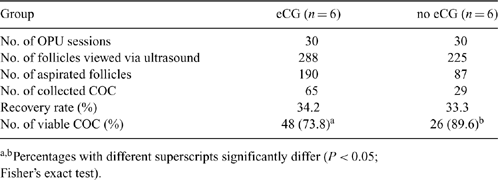438 REPEATED ULTRASOUND-GUIDED FOLLICULAR ASPIRATION IN PREGNANT SUCKLED BEEF COWS PRETREATED WITH OR WITHOUT eCG
J. F. Aller A , N. Mucci A , G. Kaiser A , G. Ríos A , B. Callejas B and R. H. Alberio AA EEA Balcarce, Instituto Nacional de Tecnología Agropecuaria (INTA), Argentina;
B Facultad de Veterinaria, Universidad Nacional del Centro de la Provincia de Buenos Aires, Argentina
Reproduction, Fertility and Development 22(1) 376-376 https://doi.org/10.1071/RDv22n1Ab438
Published: 8 December 2009
Abstract
In vivo oocyte recovery during the first trimester of pregnancy may be an alternative method of obtaining gametes for IVM/IVF/IVC from genetically valuable females. This study was conducted to evaluate i) the influence of the day of gestation on the follicular growth and number and quality of oocytes recovered by ovum pick-up (OPU) in pregnant suckled beef cows with or without eCG pre-stimulation, and ii) the possible effects on pregnancy outcome. Twelve pregnant suckled Angus cows (40 days after FTAI) were randomly assigned to 2 groups (n = 6/group). Group 1 treatment included: Day 0 = dominant follicle ablation (DFA) to synchronize the emergence of a new follicular wave, Day 1 = eCG treatment (2,000 IU, i.m. Syntex, Argentina) and Day 5 = OPU (follicles >3 mm were aspirated). Group 2: as for Group 1 with no eCG treatment. In both groups, OPU was repeated 5 times (Days 45, 59, 73, 87, and 101 of gestation) and ovarian follicles were classified into 3classes according to diameter (class I, <5 mm; class II, 5-9 mm; and class III, ≥10 mm). The collected COCs were categorized in 4 categories (I to IV) on the basis of both cumulus cells and appearance of oocyte cytoplasm. Categories I + II were considered as viable. Data were analyzed by PROC MIXED (SAS Institute, Cary, NC, USA). There was a significant treatment by follicular class interaction (P < 0.001). The numbers (mean ± SEM) of class II (4.3 ± 0.9) and III (2.5 ± 0.4) follicles/cow/session observed in eCG-treated cows were greater than for nontreated cows (0.9 ± 0.1 and 0.9 ± 0.1, respectively). In contrast, the number (mean ± SEM) of class I follicles/cow/session was lower for cows with eCG treatment (2.8 ± 0.4) than for nontreated cows (5.7 ± 0.5). A significant treatment by day of gestation interaction for aspirated follicles was observed (P = 0.03). The numbers (mean ± SEM) of recovered oocytes and viable oocytes/cow/session were greater (P < 0.05) for eCG-treated cows (2.2 ± 0.2 and 1.6 ± 0.4 respectively) than for nontreated cows (1.0 ± 0.2 and 0.9 ± 0.2, respectively). No donor pregnancies were lost either during or following OPU procedure. The overall efficiency of OPU procedure is shown in Table 1. We can conclude that (1) eCG-treated pregnant suckled cows can be a source of oocytes for IVF to at least 100 days of gestation and (2) repeated DFA/eCG treatment/OPU procedures did not affect the pregnancy outcome.

|


